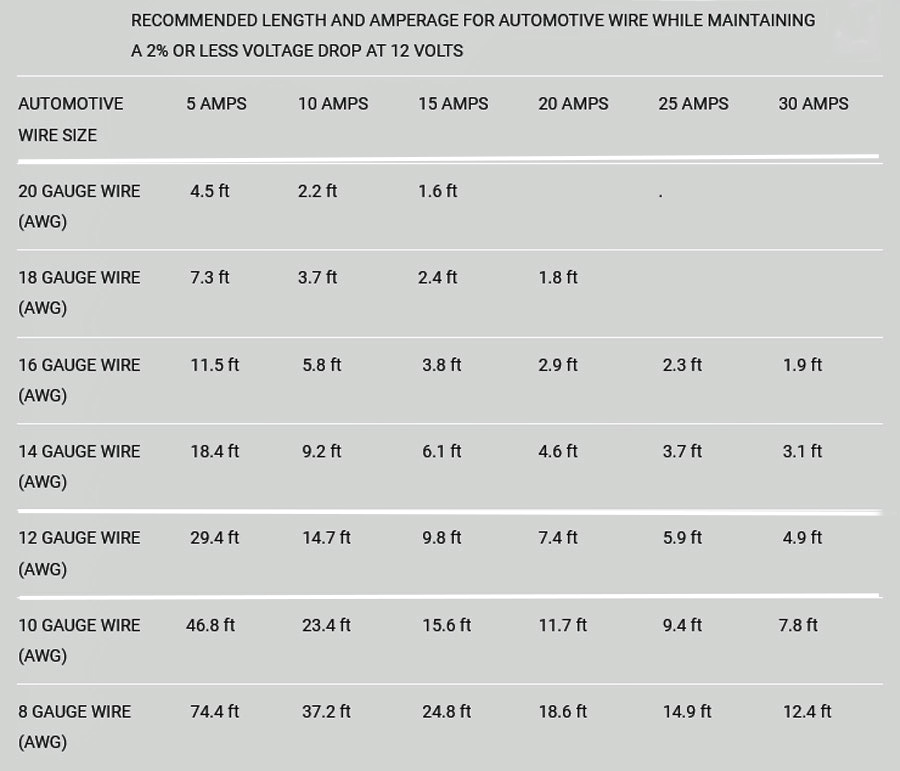
In order for your automotive electrical system to perform correctly, your wire must be sized properly based on the amount of current (amperage) the wire must carry, and the length that the wire needs to be. For example, you want to add some flood lights to your vehicle. The floodlights draw 15 amps of current. The length the wire needs to be to connect to the floodlights is 9 ft. Based on the chart above, you would want to use 12 gauge automotive wire for your floodlights.
Why is the size of an automotive wire so important? When electricity passes through a wire, The wire resists the electricity and some of it is converted into heat that is absorbed by the wire. This lost energy is realized in the form of a voltage drop at the end of the wire. In its simplest terms, you can think of 12 Volts as during 12 units of work. If you’re wire has a 2% voltage drop, then the wire is using up 0.24 volts, or units of work. That leaves 11.76 volts, or units of work left. So if you put a volt meter on your battery and read 12 volts, when you put your volt meter on the end of the wire, you will read 11.76 volts. If you are running 20 amps through your wire then your wire is absorbing 4.8 watts of power. Now let’s say your wire has a 20% voltage drop. The voltage reading on your volt meter at the end of the wire will only be 9.6 volts, and the wire is absorbing a whopping 48 watts of power!
There are two minds to the best wiring gauge. Thinner wire (higher gauge 20-24) is more flexible but a thicker gauge, as can be seen by the table to the right, transfers current more reliably and will last longer before the inevitable rotting.
Is it better to solder or to crimp connectors to automotive wire? Soldering is superior since it creates a maximum amount of surface contact between the wire and the terminal or connector. However, in 95% and more cases, a good crimp will work just as well. The key is to make sure that there is good electrical contact between the copper strands of the wire, and the barrel of the terminal or connector. Basically, if you crimp your wire and terminal together, and you cannot pull them apart, the connection will most likely suffice. It is always a good idea to cover the terminated ends of your automotive wire with some heat shrink tubing.
Little of this is done or examined by car manufacturers. Manufacturers, especially small ones without the quantities of scale buying, by on cost only. Positioning in the car is often unpleasant for owners.
1. The use of the wrong fusebox (often from the manufacturer)
2. Patching in wires of a different grade and coding
3. Abandoning Lucas coded wire in a British made car. American automotive electrical components are GREAT, but their wiring coding systems are wanting. They use limited colors or labels which means you only know what the wire you are working in difficult places every 18-12-5 inches (the latter rare). With UK coding you know what each wire is serving at any point in the wire.
| WATCHPOINT If you don't know or want to consult the Lucas wiring chart, then label the wire's usage at its ends. Buy a wire labeller) |
4. Owners do not use a proper crimper.
5. Manufacturers and owners do not use water proof connectors or Lucars.
6. Owners keep using bigger fuses rather than checking the wiring or the component for fault. Eventually a wire fire results.
7. Manufacturers and owners do not group the areas the wires are serving and reflect that in the fuse box and by wrapping them in a sheath for relevant area. The result is spaghetti behind the dash.